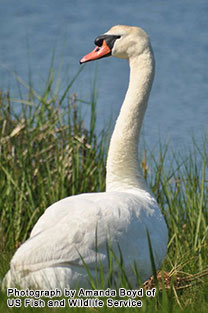Wildlife - Species

Species Specific Regulations
Mute Swans
Licenses: Hunting License required. Migratory Bird Hunting and Conservation Stamp (Federal Duck Stamp) that is validated by the hunter signing the stamp in ink across the face of the stamp
Limits: Please see Migratory Bird Regulations for any game zones restrictions or Limitations.
Mute Swan (Cygnus olor)
Description
Mute swan are large white waterfowl with a long neck and orange bill and black face.
Average Size
Mute swans have an average length of 55 inches and an average weight of 23 pounds.
Range
Mute swans are not native to the United States. They were introduced to ponds and parks where many individuals escaped and established breeding populations. Mute swans are occasionally found in South Carolina.
Preferred Habitat
Mute swans prefer temperate latitudes with shallow shorelines with plenty of submergent and emergent vegetation.
Food Habits
Mute swans mainly consume submerged aquatic vegetation.
Reproduction
Pairs form in the beginning of the year from January through April. Once paired, swans remain together throughout the year. The male selects nest sites until the female accepts the site. Both the male and female swan build the nest out of reeds, cattails, and cordgrass. Then the female lays 1-11 blue-green eggs that turn white in time.
Sound
The mute swan is not in fact mute. They make a variety of grunts, bugles, snorts, whistles and hisses, although they are not as loud as other swan species.
Behavior
- Moves well on land and can walk and run with ease.
- Highly territorial during the breeding season.
- Highly social often found in large flocks.
Citations, Publications and Literature
Ciaranca, Michael A., Charles C. Allin and Gwilym S. Jones. 1997. Mute Swan (Cygnus olor), The Birds of North America Online (A. Poole, Ed.). Ithaca: Cornell Lab of Ornithology; Retrieved from the Birds of North America Online.
